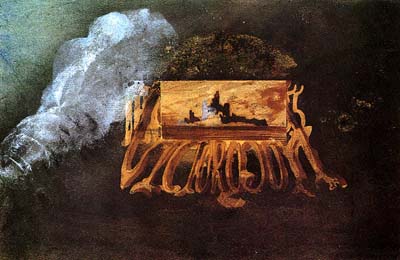
I’ve never read any of his novels (I know I should!), but I only recently learned that Victor Hugo was also an artist and painter. I can only find a couple dozen low-res images online, but the impression I get is that he was ahead of the Symbolist painting movement by a couple of decades, and was working on these around the time his fellow French writer Baudelaire was cranking out Les Fleurs du mal. In any case they’re surprisingly weird and impressionistic, and seem to employ printmaking techniques that also make me think of early photographic experiments (see for example his Silhouette Fantastique or the wonderfully creepy Lace & Ghosts).
The painting above seems to be named Calling Card and reminds me of an 1855-era Wayne White typography painting (it looks like the ornate lettering spells out VICTOR OGUH, with “Hugo” reflected backwards?)
I wish there were better scans of these available!
